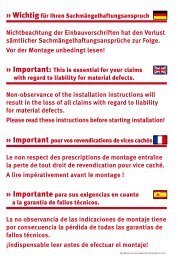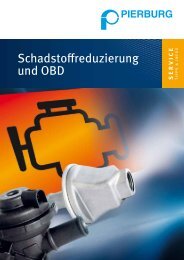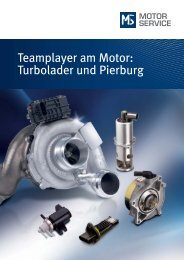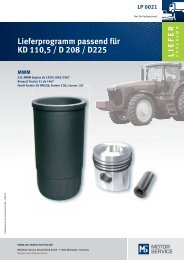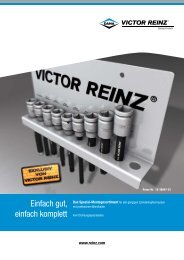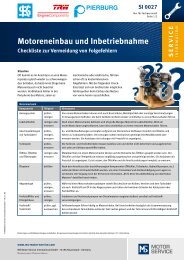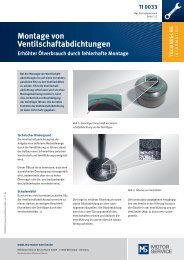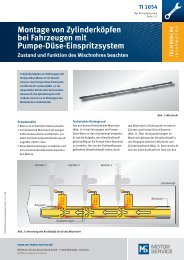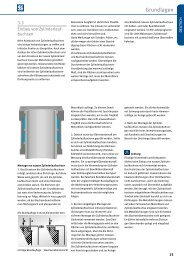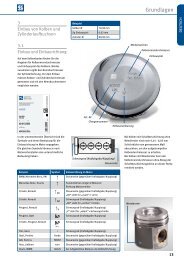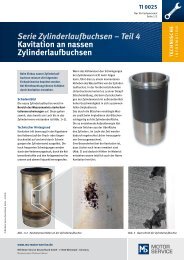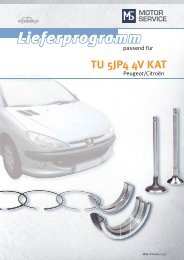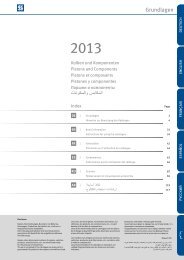Die Sonderausgabe der MTZ hier herunterladen (6 MB - MS Motor ...
Die Sonderausgabe der MTZ hier herunterladen (6 MB - MS Motor ...
Die Sonderausgabe der MTZ hier herunterladen (6 MB - MS Motor ...
Erfolgreiche ePaper selbst erstellen
Machen Sie aus Ihren PDF Publikationen ein blätterbares Flipbook mit unserer einzigartigen Google optimierten e-Paper Software.
CAPABILITIES AND COMPONENTS<br />
FOR COMMERCIAL VEHICLE ENGINES<br />
One of the primary development tasks on the commercial diesel engine is to minimize NO x and PM emissions<br />
without compromising the engine efficiency. Because of the complex interaction of combustion engine, turbocharger<br />
(T / C) and exhaust gas recirculation (EGR), the layout of air and EGR management systems calls for a highly<br />
integrated approach. To allow for this, Pierburg merged all its activities and components for the commercial vehicle<br />
and off-road sector in its Business Unit Commercial <strong>Die</strong>sel Systems (CDS) in 2009.<br />
COMPONENTS AND SYSTE<strong>MS</strong><br />
The future development of the commercial<br />
diesel engine will be dominated by the<br />
need to comply with the challenging emission<br />
targets US2010 and Euro 6 for on-road<br />
applications, and Tier 4 Final in the offroad<br />
sector. The air and EGR management<br />
system plays a key role here [1]. Thanks to<br />
its broad experience in the field of intake<br />
and EGR systems Pierburg is able to support<br />
its customers in meeting these challenging<br />
targets. Pierburg offers tried-andtested<br />
charge management products such<br />
as intake manifolds and throttle bodies,<br />
products for emission control such as EGR<br />
valves, EGR coolers, reed valves and secondary<br />
air systems as well as solenoid<br />
valves and electric actuators as positioning<br />
and control elements. The new Pierburg<br />
turbocharger rounds off the products associated<br />
with the gas exchange system.<br />
All the components are available and<br />
put to use individually or in integrated<br />
modules. The modules gain the advantage<br />
that the customer does not have to configure<br />
the individual components from those<br />
available on the market, but is receiving a<br />
system with tested and tuned components.<br />
For the success of such development<br />
tasks it is crucial to have an un<strong>der</strong>standing<br />
of the component interactions<br />
and the effects on the engine process.<br />
Accordingly, the first part of this article<br />
recapitulates the main thermodynamic interactions<br />
between the combustion engine,<br />
EGR system and turbocharger. From<br />
these interactions, component targets are<br />
then <strong>der</strong>ived in the second part.<br />
100 Years of Kolbenschmidt Pierburg<br />
NO X FORMATION AND REDUCTION<br />
During combustion NO x is mainly formed<br />
at high temperatures [2]. This chain reaction<br />
is described by the Zeldovich mechanism<br />
which, un<strong>der</strong> certain assumptions,<br />
can be restated and simplified to Eq. 1.<br />
Eq. 1 d(nNO )<br />
_____<br />
dt ~ √ ___<br />
_______<br />
n n o2 N2<br />
√ __<br />
V [ 1 ___<br />
√ __<br />
T exp ____ – E<br />
( R T m ) ]<br />
Due to the finite reaction rate, the majority<br />
of the NO molecules are borne not in the<br />
hotter flame front, but in the burned gas.<br />
Consequently, Eq. 1 mostly refers to the<br />
amount of O and N in the exhaust gas.<br />
2 2<br />
According to Eq. 1, the following ways for<br />
reducing NO formation are available:<br />
: reduced quantity of O (in the exhaust<br />
2<br />
gas). This presupposes combustion<br />
with a low AFR (a)<br />
: low quantity of N (in the exhaust gas)<br />
2<br />
(b)<br />
: high cylin<strong>der</strong> volume V during combustion<br />
(c)<br />
: low (exhaust gas) temperature T (d). This<br />
highly effective measure in view of the<br />
exponential dependency can be achieved<br />
by intensive cooling of the fresh cylin<strong>der</strong><br />
charge in or<strong>der</strong> to lower the temperature<br />
at the start of combustion (d1), a high<br />
cylin<strong>der</strong> load reducing the combustionrelated<br />
temperature gradient (d2) and late<br />
combustion timing (d3)<br />
Options (c) and (d3) have to be ruled out<br />
for efficiency reasons. (d2) must not counteract<br />
item (a). Hence, the cylin<strong>der</strong> must<br />
be charged preferably with the combustion<br />
COMMERCIAL VEHICLE TECHNIQUE<br />
products CO 2 and H 2 O. In addition, as the<br />
ratio of the specific heats is lower for the<br />
larger exhaust molecules, introducing EGR<br />
slightly reduces the temperature gradients<br />
during compression and combustion.<br />
These conclusions are un<strong>der</strong>pinned by the<br />
behavior of the throttled, homogeneous<br />
gasoline engine. For an identical, quantitative<br />
charge dilution, EGR (�=1) has a<br />
much greater effect on NO x reduction than<br />
lean combustion (� ≥ 1) [2].<br />
In practice, goals (a), (d1) and (d2)<br />
have to be achieved by charging the cylin<strong>der</strong><br />
with cooled EGR gas with a low, but<br />
still sufficient amount of O 2 [3]. Since the<br />
concentrations of N 2 in the air and the exhaust<br />
gas are almost identical, any charging<br />
(including that by EGR) increases the<br />
quantity of N 2 in the cylin<strong>der</strong>. However,<br />
this in terms of (b) counterproductive effect<br />
is more than offset by (d2).<br />
AUTHORS<br />
DR.-ING. MICHAEL BREUER<br />
is Senior Manager Components<br />
and Thermodynamics at Advanced<br />
Engineering of Kolbenschmidt<br />
Pierburg AG in Neuss (Germany).<br />
DR.-ING. MARTIN HOPP<br />
is Senior Manager in the<br />
Business Unit CDS at Pierburg<br />
GmbH in Neuss (Germany).<br />
DR.-ING. KARL WÜBBEKE<br />
is Director of the Business<br />
Unit CDS at Pierburg GmbH<br />
in Neuss (Germany).<br />
79



